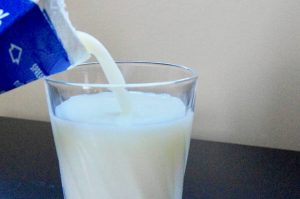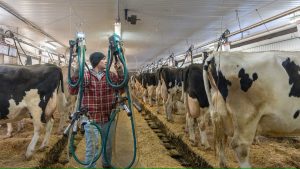
Mr. Damsteegt grew up on a dairy farm in the Netherlands, but in 1986 moved to Nova Scotia to pursue his vocation in Canada. “The main reason I came wasn’t for the weather,” he says. “It was because of supply management.”
Canadian dairy production has been governed for decades by the supply management system, under which the country’s 11,000 dairy farmers purchase production quotas, and produce only as much milk as their quota permits. Imports of dairy products are limited, provided that domestic producers can meet demand, and prices that farmers receive for their products are set by provincial regulatory boards.
The system has been the subject of fierce debate for years. Detractors suggest it stifles free-market competition and inflates food prices for consumers; advocates say it ensures that Canadian producers aren’t flooded by cut-rate imports and they receive reliable, consistent prices for production – critical for long-range planning in a capital-intensive business.
The issue has been a persistent sticking point for the government during free-trade negotiations and, in recent years, Canada has opened part of its domestic market to foreign producers. The 2017 Canada-European Union Comprehensive Economic and Trade Agreement (CETA) doubled the amount of European access to the cheese market, and the 2018 Comprehensive and Progressive Agreement for Trans-Pacific Partnership (CPTPP) opened up 3.25 per cent of the overall dairy market. Once the Canada-U.S-Mexico Trade Agreement (CUSMA) comes into force, Dairy Farmers of Canada (DFC) estimates that 8.4 per cent of Canada’s total milk market will be newly open to foreign producers.
Hence this year’s aid package, to be doled out over eight years, and aimed at mitigating the effect of lost market share. By March 31, 2020, the first $345-million will be paid directly to farmers based on the value of their quota. (Details on how the remaining $1.4-billion will be distributed in future is still being negotiated between the federal government and DFC.)
“I want to stay positive,” Mr. Damsteegt says “so certainly I have to be very clear that these trade deals aren’t helping. Getting compensation will help, but it won’t replace that lost market share.”
That’s why many farmers are now taking a hard look at exactly what they’ll do with the compensation money coming their way. For many, it will mean making long-deferred investments, consolidating operations to save on costs, or improving their operations’ efficiency – all the better to position their farms for sale or family succession.
“What happens is when these trade deals are announced, people tend to pull back on improvements and investments to see what’s going to happen,” says David Wiens, Manitoba vice-president on DFC’s national board of directors. Mr. Wien believes that’s a recipe for decline given the pace of technological change in the agriculture sector and the wear-and-tear inherent to the business.
Mr. Wiens hopes the package will inject enough confidence into the sector to encourage more modernization and improvements. With his brother, Mr. Wiens operates a third-generation family farm, milking 220 cows. The investments he’s eyeing are largely focused on cutting labour costs and improving conditions for animals, which he explains is beneficial for their comfort and welfare, and boosts their milk production.
“On some farms investments will be things like footbaths or automated brushes that cows can use to groom themselves,” Mr. Wiens says, “or even rubber mats for walking around, and misters to cool the barn in summer.”
The catch is that the money offered in the first year – an estimated $28,000 for an 80-cow farm, the average size of a Canadian operation – is a relative drop in the bucket compared to the costs of the major improvements.
Holger Schwichtenberg milks about 170 cows in British Columbia’s Fraser Valley, east of Vancouver. This summer, the 58-year-old built a new barn and installed a robotic milking system. A study by University of Calgary researchers in 2017 found that farmers who switched to robotic milkers were able to increase their milking herds by about 10 per cent, and reduce the number of employees.
“This way I’m not always beholden to milking times,” Mr. Schwichtenberg says, “and it allows the animals to choose when they’re milked, and they’re not being poked and prodded. Instead, they come and go as they please.”
But only seven per cent of Canadian farms use robotic milkers, mainly because of the daunting cost.
Mr. Schwichtenberg’s upgrade was a once-in-a-generation investment, setting him back $3-million. He hopes the operating savings put the farm in a better position should fears about tighter margins come to pass. He points out, however, that his ability to make the investments was thanks less to government compensation and more to leveraging high land values in his region – not something every farmer can rely on.
In New Brunswick, farmer John Schenkels runs a 185-cow farm near Miramichi, in the province’s north. He’s planning to consolidate his farm with another, bringing the total to around 500 animals in one facility – an order of magnitude larger than the average Canadian milking herd of 80.
“We’ve spent a lot already, made the decision to get more efficient two years ago,” Mr. Schenkels says. “A new barn and robotics, so that investment’s been made. But we’ll have to look for more to drive our cost of production down.”
Mr. Schenkels describes the situation facing many farmers in his region as “expand or retire” and believes the loss of market share may tilt some producers in the latter direction. “I definitely think it’ll affect willingness for young people to get involved.”
That’s the situation facing Mr. Damsteegt, who, at 56, is exactly the median age of a typical Canadian farmer. He’s hoping to re-invest enough to prepare the farm for any of his own children – now in their teens and early 20s – who may want to take over. He’s eager to see what form the compensation takes in subsequent years and hopes the government is committed to helping ensure the industry will remain viable for future generations.
“[My children] do wonder, ‘where is it going to stop?’,” he says. “So it’s a concern, and they have lots of questions. But like anything in life, you have to be willing to take some risks.”

























